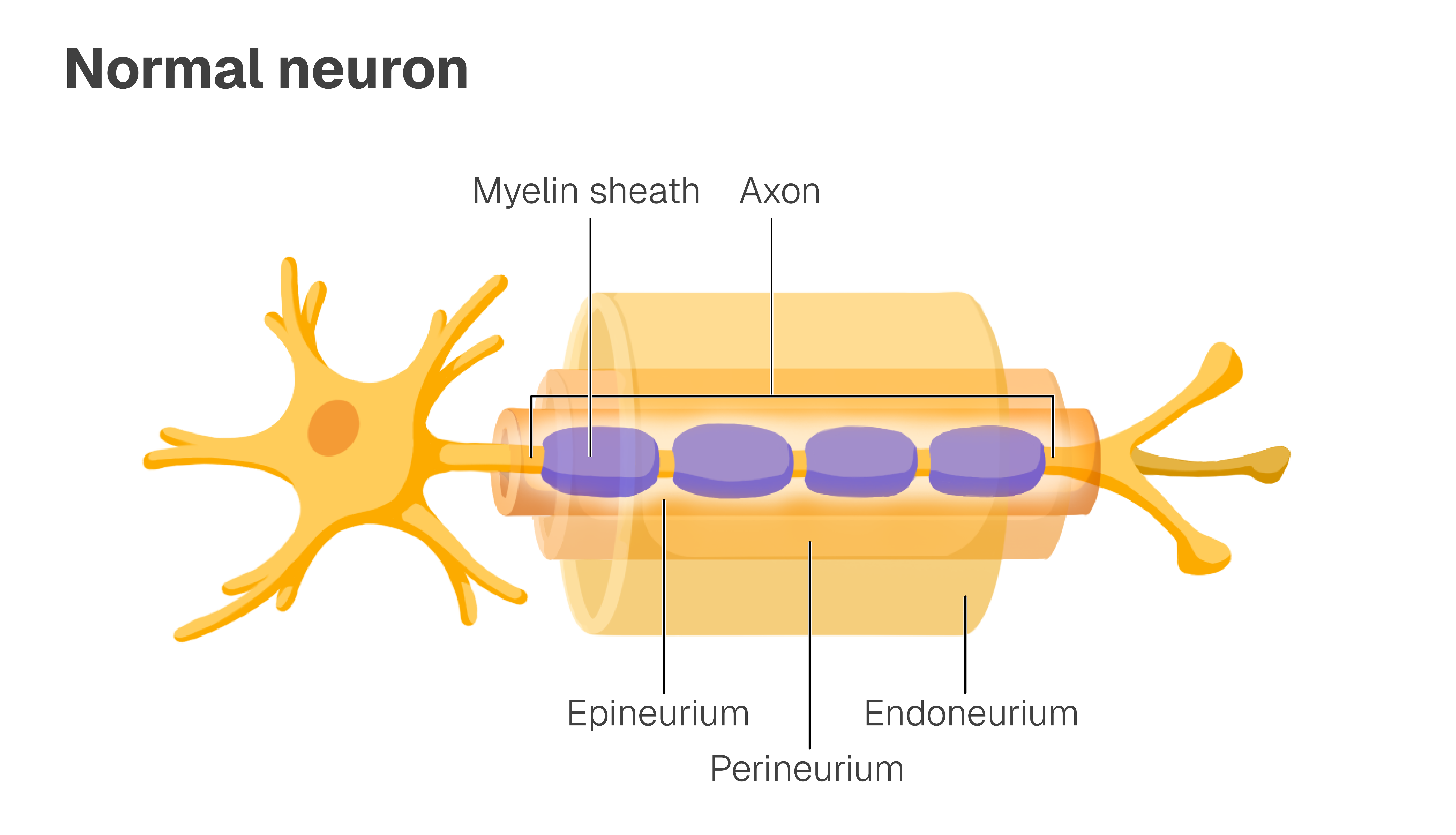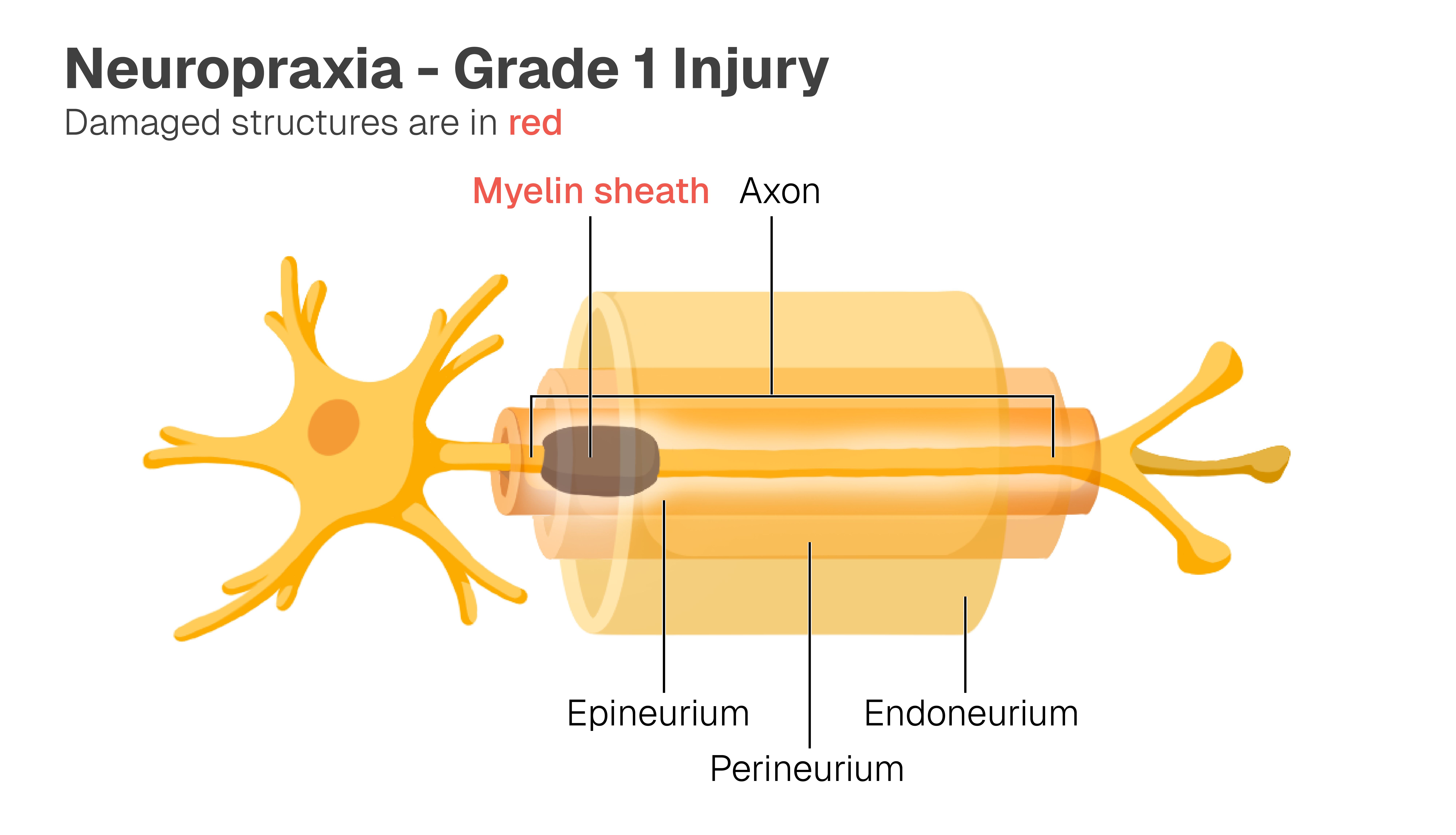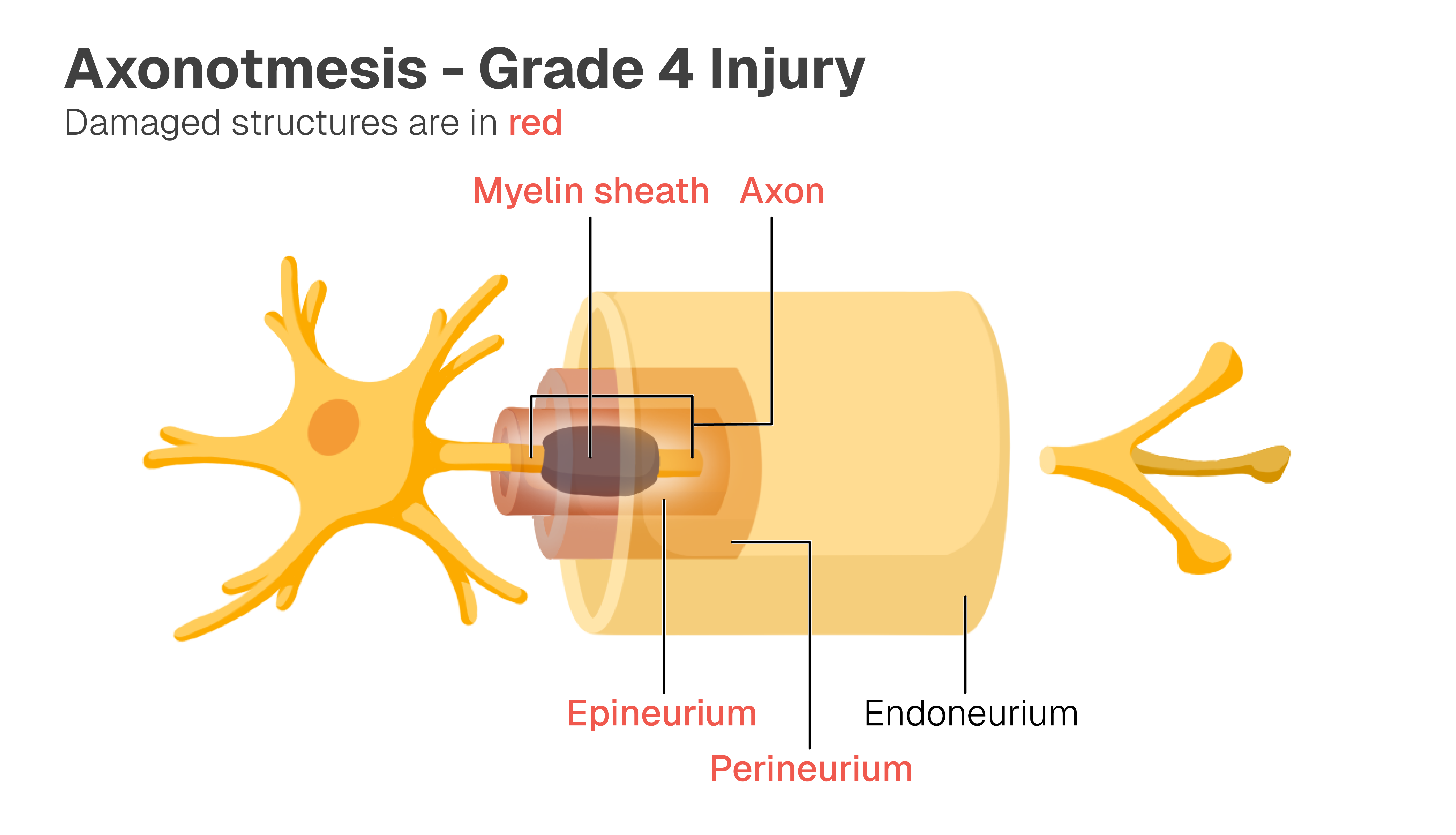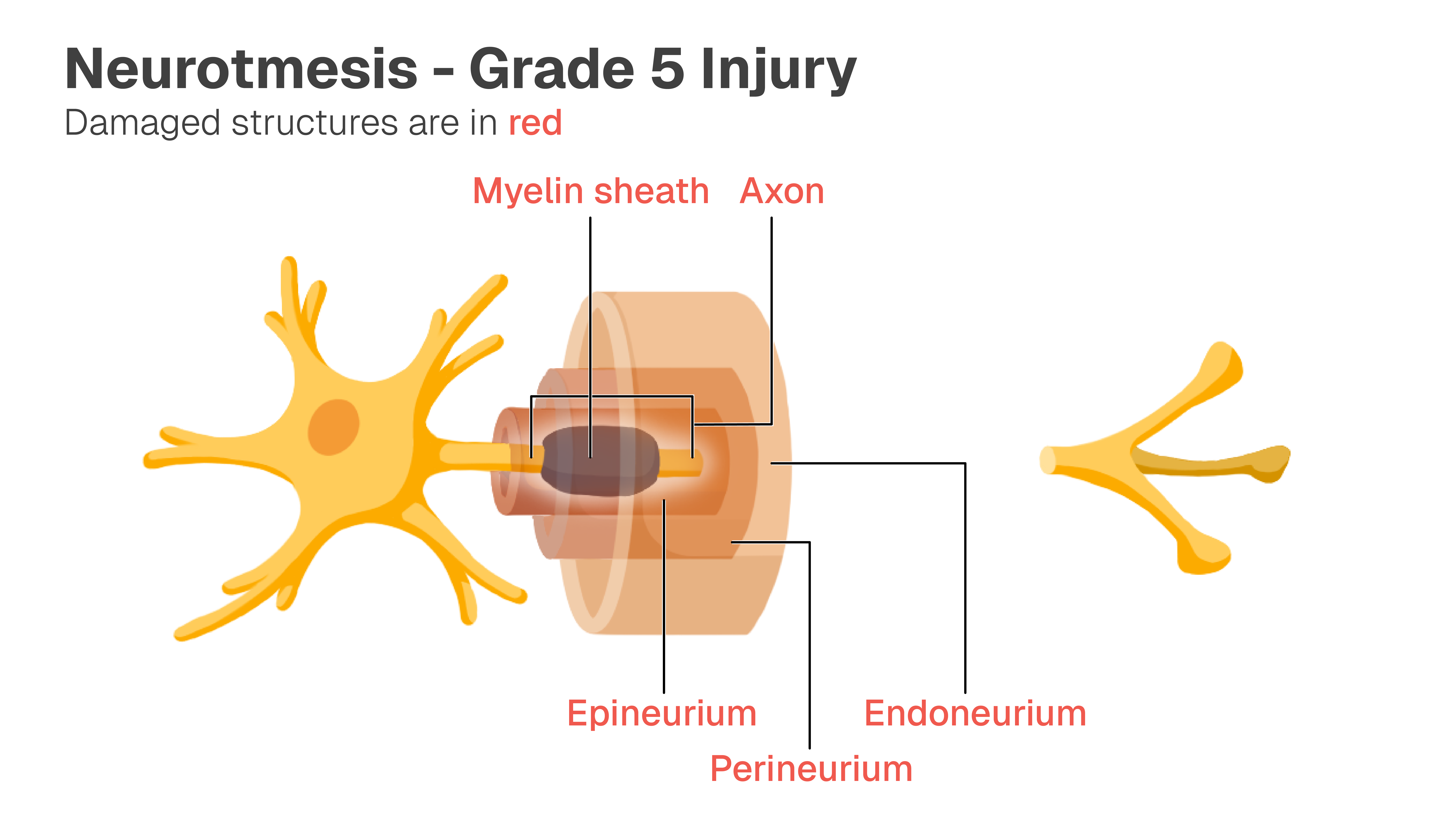Understanding PNI
Understanding PNI
Anatomy of a Nerve
What is a nerve?
Nerves (nurvz) help us sense and react to the world around us. They connect our brain to the rest of our body so we can feel the things around us and move our muscles. There are two main types of nerves:
Sensory nerves (SEN-sur-ee nurvz) help you touch and feel things around you, such as a hot cup of coffee. When you touch the cup, sensory nerves will send touch information to your brain so you realize it is hot.
Motor nerves (MOH-ter nurvz) can activate your muscles, sometimes to respond to a sensation like heat or pain. They carry signals from your brain that tell your muscles to stop, continue, or start moving.
What is the structure of a nerve?
This is another representation of a neuron, or a nerve cell. These are the building blocks of how nerves can send signals between the brain and body.
Hover over different parts of the neuron below to learn about the different parts of it.
The Peripheral Nervous System
What is the peripheral nervous system?
Nerves, the spinal cord, and the brain make up our nervous system. The nervous system can be divided into two parts:
- The central nervous system (CEN-trul NUR-vus SIS-tem) includes your brain and spinal cord. It sends signals to the rest of the body.
- The peripheral nervous system (purr-IF-er-al NUR-vus SIS-tem) includes all the nerves outside of the central nervous system. It sends signals to the spinal cord and the brain.
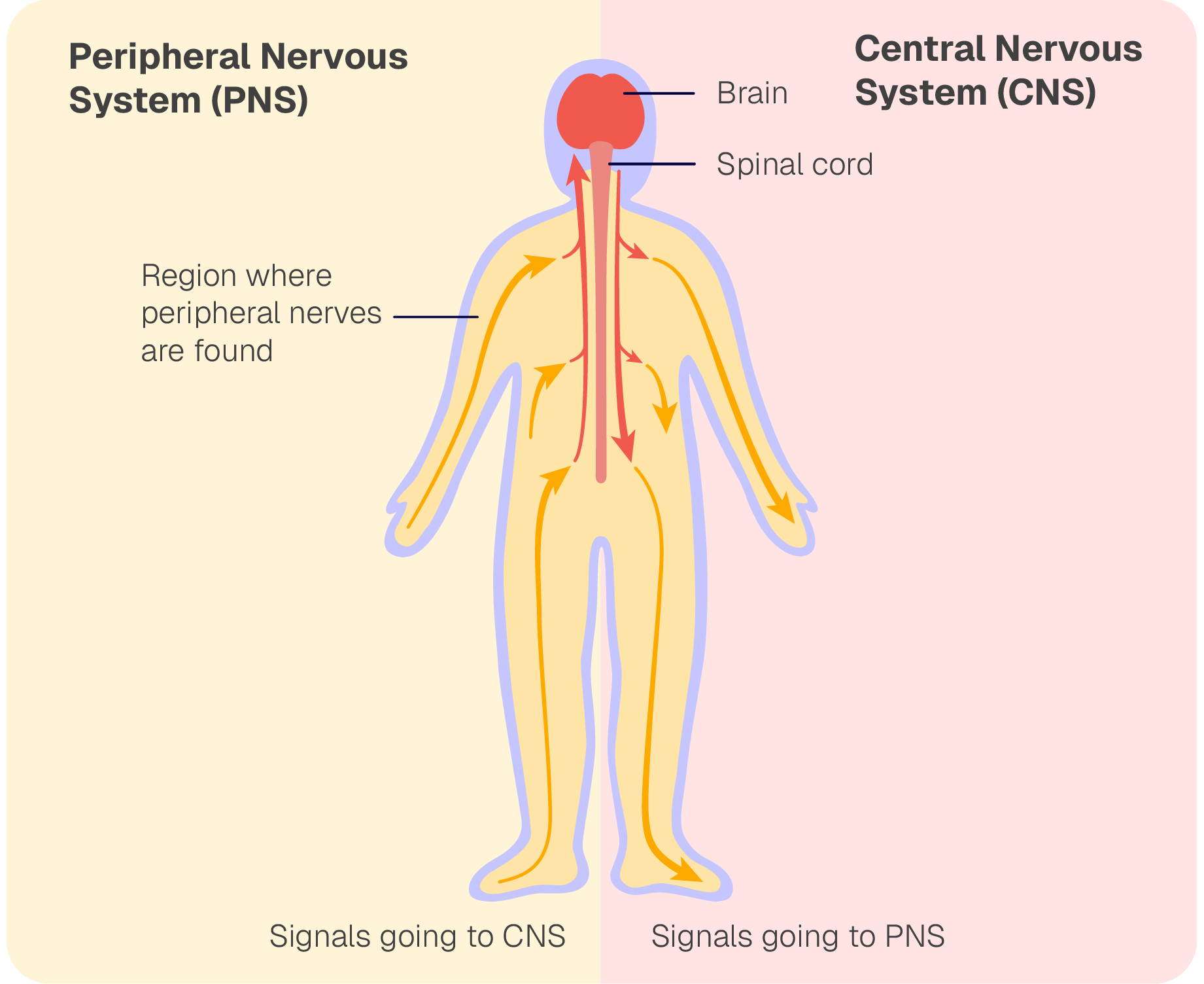
What is peripheral nerve injury?
Peripheral nerve injury occurs means nerves in the peripheral nervous system have been damaged. Peripheral nerve injury (PNI) can affect your muscles or how you sense things around you. Some common symptoms of PNI are:
- Muscle weakness,
- Tingling/numbness,
- or pain.
Not everyone will have the same symptoms. Many different aspects of the injury can affect muscle strength or feeling.
Before your visit, it can be helpful to write down any changes you've noticed in your body or lifestyle after the injury. This can include:
- Where you feel pain and what the pain feels like. For example, dull pains or sharp shooting pains.
- When you feel pain or discomfort, how long it lasts, and what makes it better or worse.
- Tasks that are harder to complete.
Classifying an Injury
How can peripheral nerve injury happen?
Hover over each image to see how the injury occurs. (Click on mobile.)
Compression/Crush Injury
Compression (come-PRESH-un): The nerve is squeezed over time.
Crush: A more serious form of compression caused by a sudden, hard blow.
Most injuries are less severe and reversible.
Traction Injury
Traction (TRAK-shun): The nerve is stretched or pulled, which can lead to rips in the nerve.
Injuries can be more or less severe depending on much the nerve is stretched.
Laceration/Transection Injury
Laceration (lah-sur-A-shun): Incomplete cutting of the nerve, usually from a sharp object.
Transection (tran-SEK-shun): The nerve is completely cut and can only be repaired through surgery.
What are the categories of PNI?
Peripheral nerve injury can be categorized by the severity of the injury, which depends on what nerve tissues are damaged.
The image below shows the different levels of peripheral nerve injury and which structures are damaged at each level.
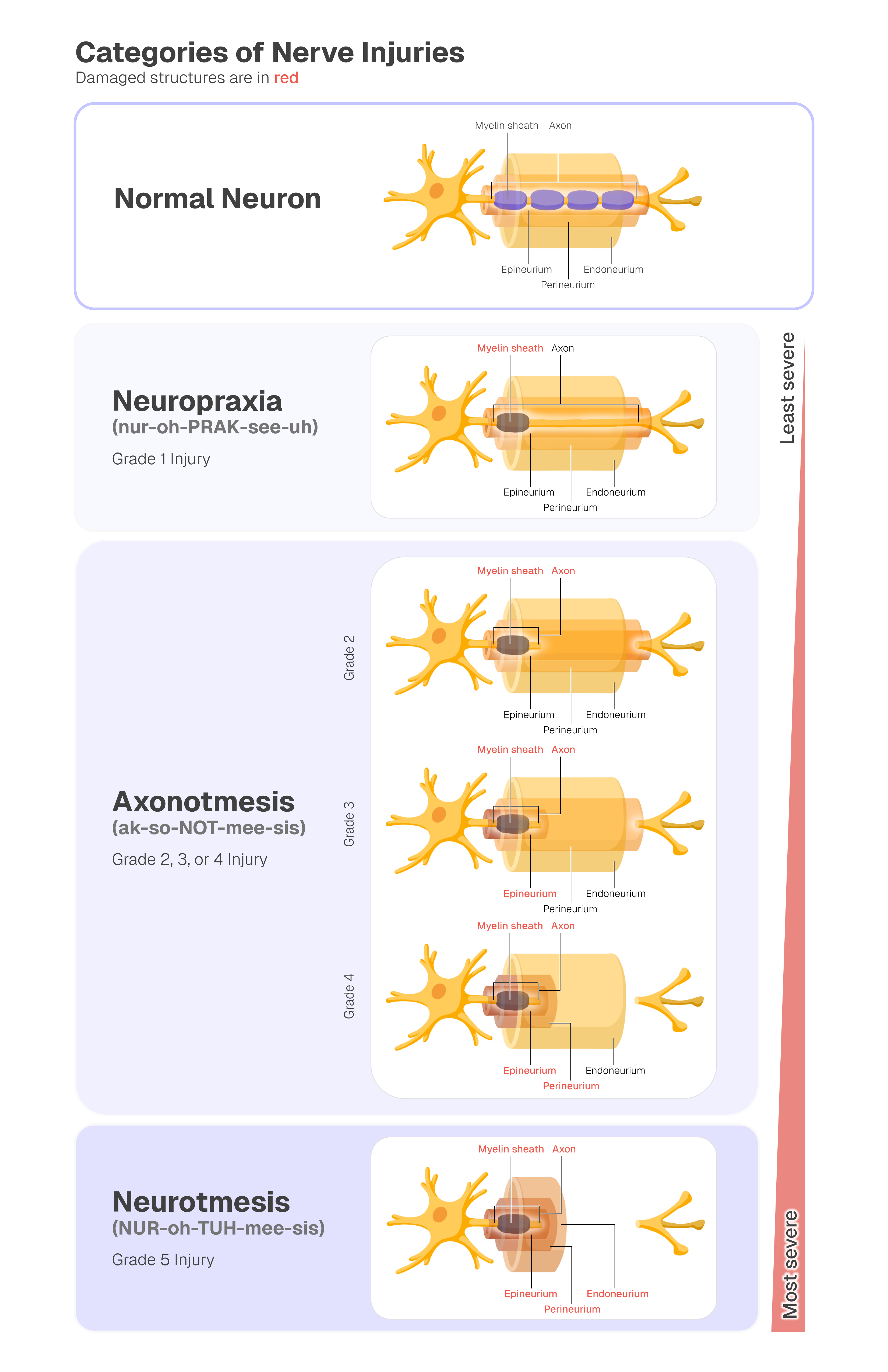
For more details, click through the different tabs to explore how PNI is categorized.
Neuropraxia (nur-oh-PRAK-see-uh) - Grade 1 Injury
Structural changes: The myelin sheath is damaged, but the axon and all of the surrounding connective tissues are healthy.
Symptoms: Pain, muscle weakness, or numbness.
Outcomes: Usually complete recovery is possible.
Axonotmesis (ak-so-NOT-mee-sis) - Grade 2, 3, or 4 Injury
Structural changes: The myelin sheath AND axons are damaged. The connective tissue layers may also be damaged.
- Grade 2: None of the connective tissues are damaged.
- Grade 3: The endoneurium is also damaged.
- Grade 4: The endoneurium and perineurium are damaged.
Symptoms: Pain, different amounts of motor and/or sensory loss depending on how severe the injury is.
Outcomes: Recovery is possible, but could take longer if there is more damage. The higher the grade of injury, the less likely it is for the nerve to completely heal.
Neurotmesis (NUR-oh-TUH-mee-sis) - Grade 5 Injury
Structural changes: The nerve is fully cut, including through the myelin sheath, axons, and all layers of the connective tissue.
Symptoms: Severe pain, complete motor and/or sensory loss.
Outcomes: Axons cannot grow back because the nerve is fully cut or scar tissue blocks the way. Surgery is needed for any sort of recovery to occur.
Arm Injuries
Nerves in the Arm
How are nerves in the arm organized?
On both sides of the body, a web of nerves called the brachial plexus (BRAY-key-al PLEK-sus) is located near the collarbone. Nerves from the spinal cord become part of the brachial plexus and go to muscles and skin in the arm.
The nerves from the brachial plexus are responsible for arm sensation and movement.
Because nerves will travel all the way from the spinal cord to your fingers, any injury that breaks or disrupts nerve connections will impact nerve function.
Types of Injuries
What happens when nerves in the arm are damaged?
Any nerve or combination of nerves may be damaged in peripheral nerve injury. Terminal nerves can be individually damaged and also require surgical treatment.
When the injury is closer to the neck, more of the arm will be affected.
If you feel pain, tingling, or numbness in your arm, nerves involved in sensation are injured. If your arm feels weaker, nerves involved in movement are injured.
Brachial Plexus Injury
Brachial plexus injury can be more severe and complex because the brachial plexus is closer to the spinal cord. This means that many arm functions or sensations may be impacted.
Trunk Injuries
Brachial plexus injuries can be categorized by the area of the plexus involved. When different parts of the trunk are injured, this can lead to different symptoms.
Click through the different tabs to learn about different types of brachial plexus injuries.
Upper Trunk Injury: Nerves that make up the upper trunk send signals to the upper area of the arm and shoulder.
- Upper trunk injury can cause loss of feeling or numbness in the shoulder, outside of arm, and thumb.
- You may find it hard to lift your arms up, bend your elbows, or feel like your arm is weak in general.
- In extreme cases, you may not be able to use your shoulder muscles and biceps at all.
Middle Trunk Injury: Injury to the middle trunk can affect some muscles in your wrist and forearm.
However, it's not likely for the middle trunk to be injured by itself because of its location. Usually, injury will happen with other parts of the brachial plexus.
Lower Trunk Injury: When the lower trunk alone is injured, the shoulder and elbow are usually okay, but hand function is affected.
- Your hand may naturally form a claw at rest.
- It may be hard to performing fine motor tasks like picking up coins.
- You may also experience numbness in areas of your hand and fingers.
Pan Plexus Injury: In a pan-plexus injury, all three trunks are damaged, leading to complete paralysis of the arm and hand.
Even if your symptoms don’t match these descriptions exactly, they are still valid.
It's important to talk to your care team about any symptoms you're having. Sharing this information helps your care team better understand what you're going through and provide treatment and support that's right for you.



